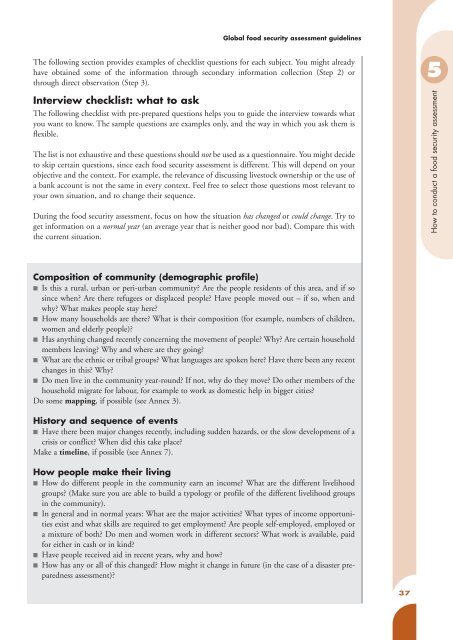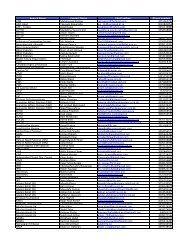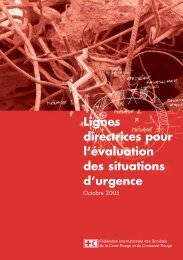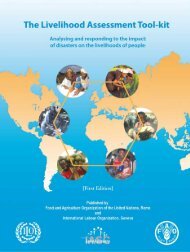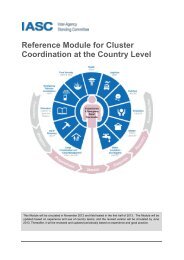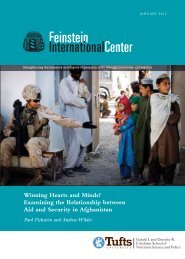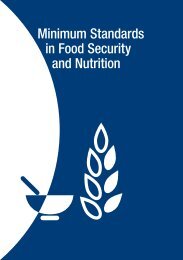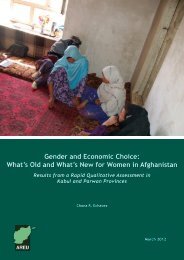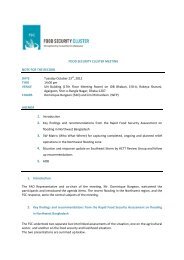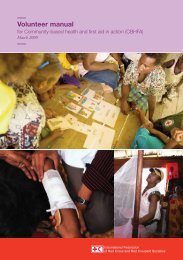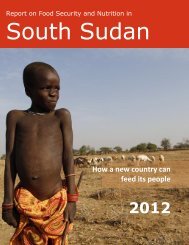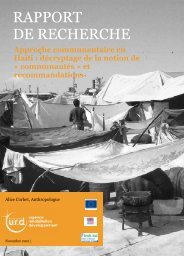Global food security assessment guidelines: A step-by - International ...
Global food security assessment guidelines: A step-by - International ...
Global food security assessment guidelines: A step-by - International ...
Create successful ePaper yourself
Turn your PDF publications into a flip-book with our unique Google optimized e-Paper software.
<strong>Global</strong> <strong>food</strong> <strong>security</strong> <strong>assessment</strong> <strong>guidelines</strong>The following section provides examples of checklist questions for each subject. You might alreadyhave obtained some of the information through secondary information collection (Step 2) orthrough direct observation (Step 3).Interview checklist: what to askThe following checklist with pre-prepared questions helps you to guide the interview towards whatyou want to know. The sample questions are examples only, and the way in which you ask them isflexible.The list is not exhaustive and these questions should not be used as a questionnaire. You might decideto skip certain questions, since each <strong>food</strong> <strong>security</strong> <strong>assessment</strong> is different. This will depend on yourobjective and the context. For example, the relevance of discussing livestock ownership or the use ofa bank account is not the same in every context. Feel free to select those questions most relevant toyour own situation, and to change their sequence.During the <strong>food</strong> <strong>security</strong> <strong>assessment</strong>, focus on how the situation has changed or could change.Trytoget information on a normal year (an average year that is neither good nor bad). Compare this withthe current situation.5How to conduct a <strong>food</strong> <strong>security</strong> <strong>assessment</strong>Composition of community (demographic profile)■ Is this a rural, urban or peri-urban community? Are the people residents of this area, and if sosince when? Are there refugees or displaced people? Have people moved out – if so, when andwhy? What makes people stay here?■ How many households are there? What is their composition (for example, numbers of children,women and elderly people)?■ Has anything changed recently concerning the movement of people? Why? Are certain householdmembers leaving? Why and where are they going?■ What are the ethnic or tribal groups? What languages are spoken here? Have there been any recentchanges in this? Why?■ Do men live in the community year-round? If not, why do they move? Do other members of thehousehold migrate for labour, for example to work as domestic help in bigger cities?Do some mapping, if possible (see Annex 3).History and sequence of events■ Have there been major changes recently, including sudden hazards, or the slow development of acrisis or conflict? When did this take place?Make a timeline, if possible (see Annex 7).How people make their living■ How do different people in the community earn an income? What are the different livelihoodgroups? (Make sure you are able to build a typology or profile of the different livelihood groupsin the community).■ In general and in normal years: What are the major activities? What types of income opportunitiesexist and what skills are required to get employment? Are people self-employed, employed ora mixture of both? Do men and women work in different sectors? What work is available, paidfor either in cash or in kind?■ Have people received aid in recent years, why and how?■ How has any or all of this changed? How might it change in future (in the case of a disaster preparedness<strong>assessment</strong>)?37


